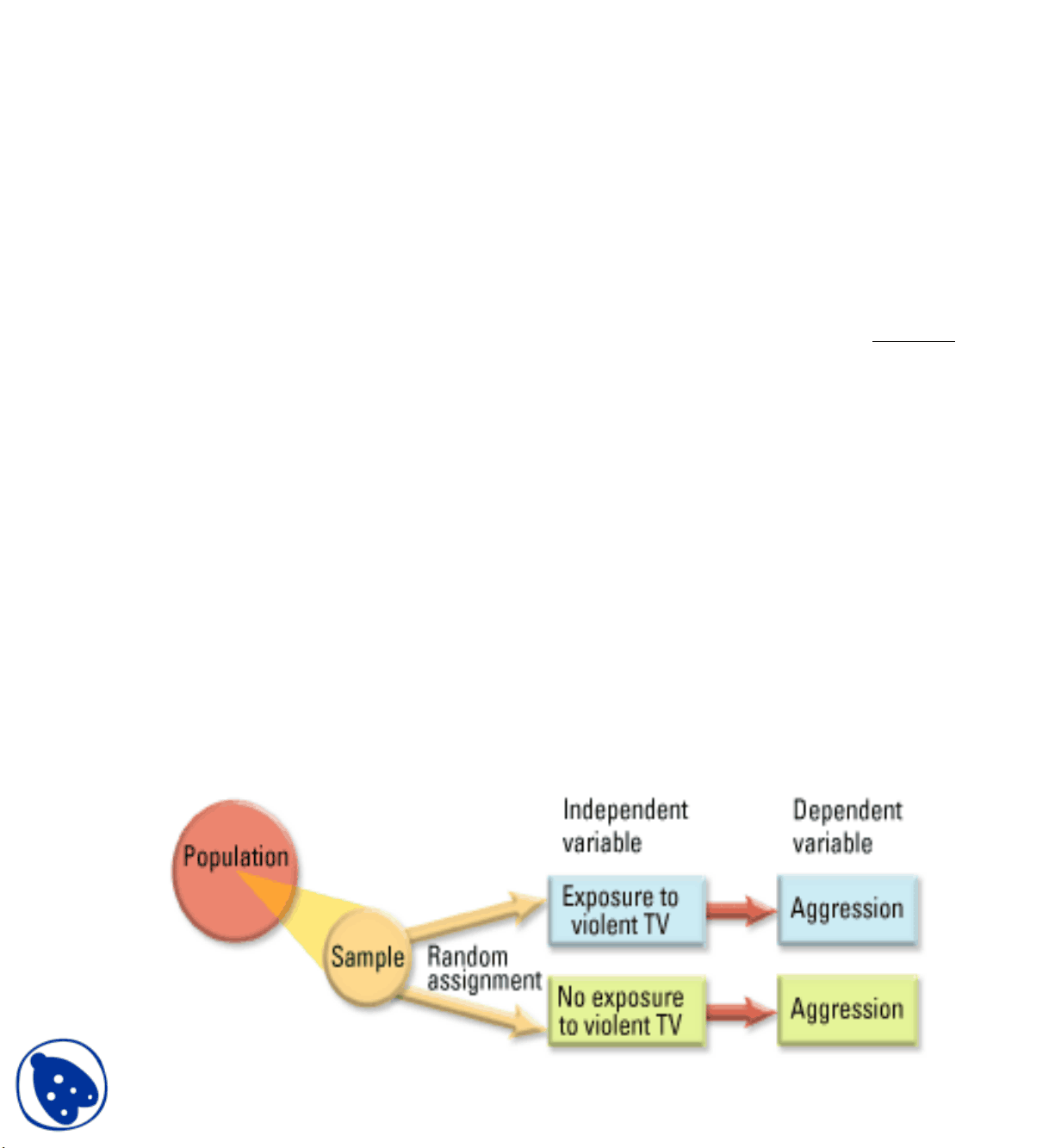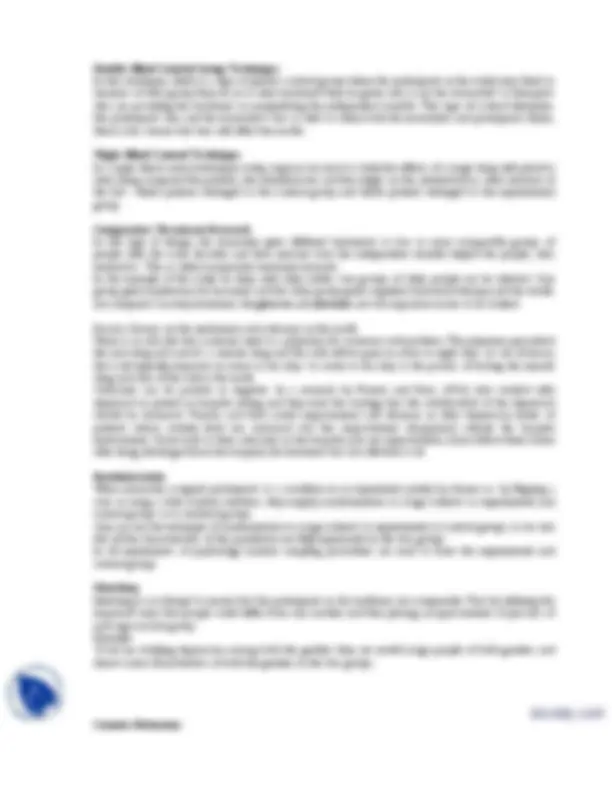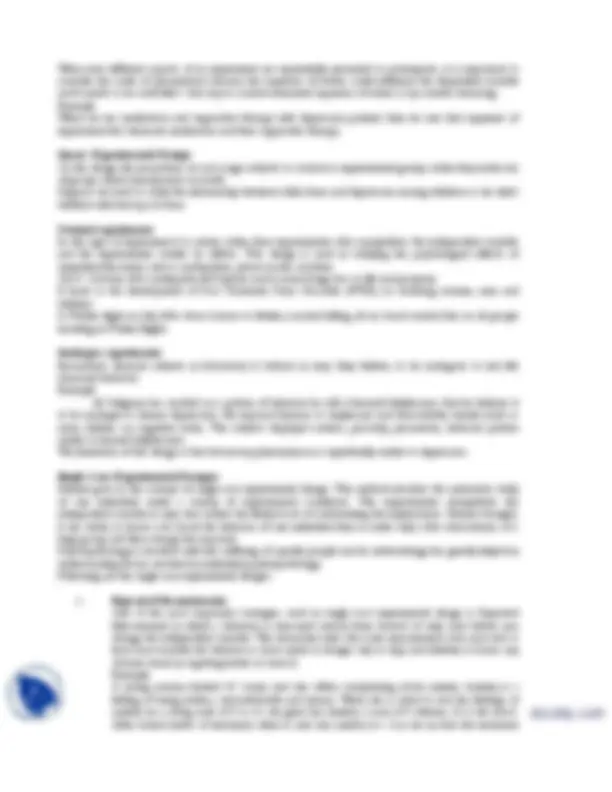





Study with the several resources on Docsity

Earn points by helping other students or get them with a premium plan


Prepare for your exams
Study with the several resources on Docsity

Earn points to download
Earn points by helping other students or get them with a premium plan
Community
Ask the community for help and clear up your study doubts
Discover the best universities in your country according to Docsity users
Free resources
Download our free guides on studying techniques, anxiety management strategies, and thesis advice from Docsity tutors
The relationship between social supports and psychological disorders, and the use of experimental designs and techniques such as group experimental designs, control groups, placebo control groups, and single case experimental designs to study the correlation. The document also covers the importance of randomization and quasi-experimental designs.
Typology: Exercises
1 / 6

This page cannot be seen from the preview
Don't miss anything!




An experiment involves manipulation of an independent variable and the observation of its effects. We manipulate an independent variable to answer the question of causality. If we observe a correlation between social supports and psychological disorders, which are two variables, we can change the extent of social supports and see its effect on prevalence of psychological disorders. So, we are carrying out an experiment or a test. What will this experiment tell us about the relationship between these two variables? If we increase social supports and find no change in the frequency of psychological disorders, it can mean that lack of social support does not cause psychological problems. If we find that psychological disorders decrease or diminish with increase social supports, we can be sure that non-support does contribute to them.
Experiment Experiment is a deliberate manipulation of a variable to see if corresponding changes in behavior result, allowing the determination of cause-and-effect relationships. Independent variable (IV) is variable in an experiment that is manipulated by the experimenter. Dependent variable (DV) is variable in an experiment that represents the measurable response or behavior of the subjects in the experiment. An experiment is a research procedure in which a situation or a behavior or both are manipulated and the effect of the manipulation is observed. Most of us perform experiments throughout our lives without knowing that we are actually behaving in a scientific manner of conducting an experiment. (Manipulation is introducing and withdrawing a variable that would not have occurred naturally).
Research by Experiment An experiment involves manipulation of an independent variable and the observation of its effects. We manipulate an independent variable to answer the question of causality. If we observe a correlation between social supports and psychological disorders, which are two variables, we can change the extent of social supports (independent variable) and see its effect on prevalence of psychological disorders (dependent variable). So, we are carrying out an experiment or a test. What will this experiment tell us about the relationship between these two variables? If we increase social supports there is decrease in prevalence of psychological disorders (negative correlation) or decrease in social supports increase in prevalence of psychological disorders( negative correlation). Take another example exposure to violent television develops aggression in children
.
Following are the Experimental Designs to be studied 1- Group Experimental Designs 2- Single Experimental Designs
Group Experimental Designs In group experimental designs, an independent variable is changed to see how the behavior of the people in the group is affected. Example: Suppose we design a treatment to help reduce insomnia in older adults, (Mellinger, Balter, 1985). The experimenters treated twenty individuals and followed them for ten years to see whether their sleep patterns improved. So the treatment is independent variable and the sleep pattern is dependent variable. The researchers found that the adults, who were treated for sleep problems still sleep less than eight hours per night. Is the treatment a failure? May be not. The question that cannot be answered is what would have happened to group members if they had not been treated. May be their sleep patterns would have been worst. We do not know. We cannot go back in time. The goal of every experiment is to isolate and identify the true or primary cause from host of other possible causes. The major obstacle to isolating the true cause is the confounding variables. We can control the confounding variable effect by using following methods.
Control Groups One answer to this problem is that we can use control groups. In the same experiment on study of sleep a control group consists of people who are similar to experimental group in every way except that they are not exposed to the independent variable. This group of people can be assessed ten years later and their sleep patterns can be observed over time. The researchers may observe that control group people sleep few hours less as they get older as compared to experimental group. The control allows the researchers to see that the treatment did help the experimental group subjects. Control group subjects match with experimental group in age, gender, socio-economic background and problems they are reporting. The only difference between both the groups is of treatment variable (independent variable).
Placebo Control Groups People in the experimental group often expect to get better. So when behavior changes, as a result of people’s expectations rather than due to independent variable we label the phenomenon as placebo affect. The word placebo means “I Shall Please” in other words placebo means inactive medications such as sugar coated empty pills. The placebo is given to the members of control group to make them believe that they are getting treatment. (Parloff, 1986). A placebo control in a medication study can be carried out because people in the control group receive something that “looks like” medicine that the experimental group is getting. If the therapists want their clients to expect improvement, this placebo affect helps strengthen the treatment.
Single Blind Control Group Technique Single blind control group technique is a kind of placebo control group procedure where the participants in the study (are) blind or un-aware of what group they are in or what treatment they are given. This type of control eliminates participant’s bias which may affect the results.
When ever different aspects of an experiment are sequentially presented to participants, it is important to consider the order of presentation because the sequence of events could influence the dependent variable and it needs to be controlled. One way to control unwanted sequence of events is by counter balancing. Example When we use medication and supportive therapy with depression patients then be sure that sequence of experiment first demands medication and then supportive therapy.
Quasi- Experimental Design In this design the researchers do not assign subjects to control or experimental groups rather they make use of groups which already exists in world. Suppose we want to study the relationship between child abuse and depression among children so we select children with history of abuse.
Natural experiments In this type of experiment it is nature rather then experimenter who manipulates the independent variable and the experimenter studies its effects. This design is used in studying the psychological effects of unpredictable events such as earthquakes, plane crashes and fires. On 8th^ October 2005 earthquake hit Pakistan and it caused huge loss to life and property. It leads to the development of Post Traumatic Stress Disorder (PTSD) in surviving women, men and children. A Fokker flight in July 2006 from Lahore to Multan crashed killing all on board created fear in all people traveling in Fokker flights.
Analogue experiments Researchers demand subjects in laboratory to behave in ways they believe, to be analogous to real life abnormal behavior. Example M. Seligman has worked on a pattern of behavior he calls it learned helplessness that he believes it to be analogue to human depression. He exposed humans to unpleasant and unavoidable stimuli (such as noise, failures on cognitive tasks). The subjects displayed sadness, passivity, pessimistic, behavior pattern similar to learned helplessness. The limitation of this design is that laboratory phenomenon is superficially similar to depression.
Single Case Experimental Designs Skinner gave us the concept of single case experimental design. This method involves the systematic study of one individual under a variety of experimental conditions. The experimenter manipulates the independent variable in ways that reduce the likely hood of confounding the explanations. Skinner thought, it was better to know a lot about the behavior of one individual then to make only a few observations of a large group and then average the response. Psychopathology is involved with the suffering of specific people and its methodology has greatly helped in understanding factors involved in individual psychopathology. Following are the single case experimental designs.
has reduced her anxiety? Not necessary. Using the repeated measurement techniques, we can measure client A’s anxiety each day during the week before her visit to the office and observe that the ratings differ greatly. On a good day she rated her anxiety 5 and on a bad she rated her anxiety at 8. Repeated measurement techniques helps to identify how a person is doing before and after treatment. We can conclude that client A had good and bad days both before and after treatment and doesn’t seem to have change much. There are important parts of repeated measurements: i. The degree of behavior change with different interventions. ii. The degree of behavior change over time. iii. The trend and direction of behavior change.
Shortcomings of single subject designs Single subject designs has disadvantage such as: i. Their results cannot be generalized. Research by experiment takes into account: i. The concept of experiment. ii. Independent variable, dependent variable and the confounding variable.